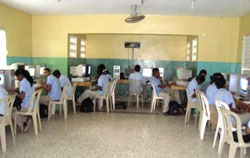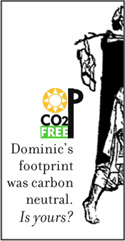Your Carbon Footprint
Here are three steps you can take, individually and/or as part of an organization, to be part of the solution:
Step 1: Reduce Your Carbon Footprint
The first and most important step for westerners who wish to address climate change is to reduce our carbon footprint as soon, and as much, as possible:
Drive less and/or share rides ♦ reduce air travel ♦ buy locally grown food ♦ convert to compact fluorescent bulbs ♦ eat less meat ♦ seal air leaks and improve insulation ♦ lower your thermostat in winter and raise it in summer ♦ turn off lights and unplug unused appliances and electronics (to reduce “phantom load”) ♦ wash clothes in cold water and hang outdoors to dry ♦ buy lightly or none-packaged goods ♦ compost kitchen scraps ♦ recycle ♦ buy renewable energy if available from your provider…
Step 2: Measure Your Carbon Footprint
After doing all you can to reduce your carbon footprint, at yearend measure the carbon you have added to the atmosphere through your home energy use, driving/flights, and lifestyle.
The more detailed information you have on household energy use, car mileage, and air travel, the more precise the measurement of your carbon footprint. Even if you only have general information, however, you can still obtain an approximate measurement of your annual carbon impact on Earth.
How to calculate your carbon footprint:
a) Primary Energy Use: Go to an online “carbon calculator” to measure the carbon emissions resulting from your use of energy at home and in travel, e.g.: http://www.carbonfund.org/Calculators.
b) Secondary Energy Use: Next calculate the amount of carbon emissions you are responsible for as a result of your lifestyle choices:
- 3.35 tons: I am a vegetarian. I mostly buy local and organic food, recycle most waste, buy essential furniture and equipment and new clothes only when needed, and occasionally go out to movies, restaurants. (3.10 tons if you are a vegan.)
- 3.90 tons: I mostly eat fish or white meat. I mostly buy local and organic food, recycle most waste, buy essential furniture and equipment and new clothes only when needed, and occasionally go out to movies, restaurants.
- 4.20 tons: I eat a mix of white and red meat. I mostly buy local and organic food, recycle most waste, buy essential furniture and equipment and new clothes only when needed, and occasionally go out to movies, restaurants.
- Add .50 tons to any of the above if you do not notice where the food you purchase comes from or whether it is organic.
- Add .35 tons or 1 ton to any of the above if you only recycle some of your waste or none of your waste.
- Add .50 tons to any of the above if you do not notice where the food you purchase comes from or whether it is organic.
c) Primary Energy Use + Secondary Energy Use = Your Carbon Footprint of ______Tons.
Step 3: Offset Your Carbon Emissions
The final step is to make an investment in clean renewable energy sources that will have a positive impact, equal to your carbon emissions—and thus achieve carbon neutrality.


Check to see if your local community has an offset fund where resources are invested in helping to weatherize low-income homes. We have used NativeEnergy www.nativeenergy.com, a reputable company that acts as an intermediary to enable organizations and individuals help build renewable energy projects (see Tufts Climate Initiative).
We are now investing in the El Cruce Carbon Offset Fund. It is not a carbon offset company like NativeEnergy, which meticulously measures impact. Instead it is a project established by Adrian Dominican Sisters to acknowledge the carbon debt that wealthier, carbon-emitting nations owe to poorer nations bearing the brunt of climate change. Sisters, Associates, and others make annual carbon “debt” payments into the fund, equal to $10 per ton of their carbon footprint. The monies are invested in solar-energy development and training at a K-12 school the Sisters helped found in a poor, rural part of the Dominican Republic.
![]()



